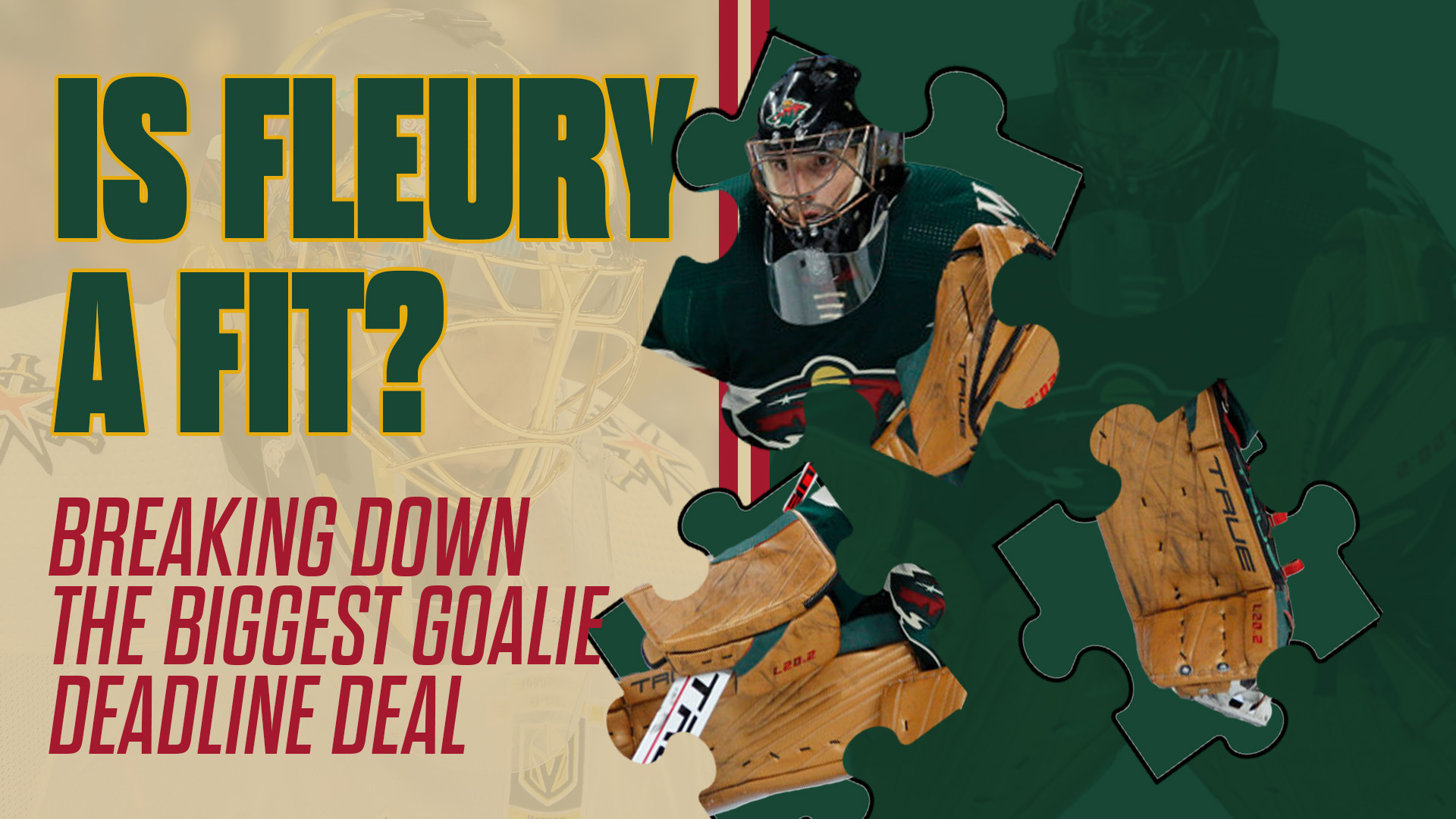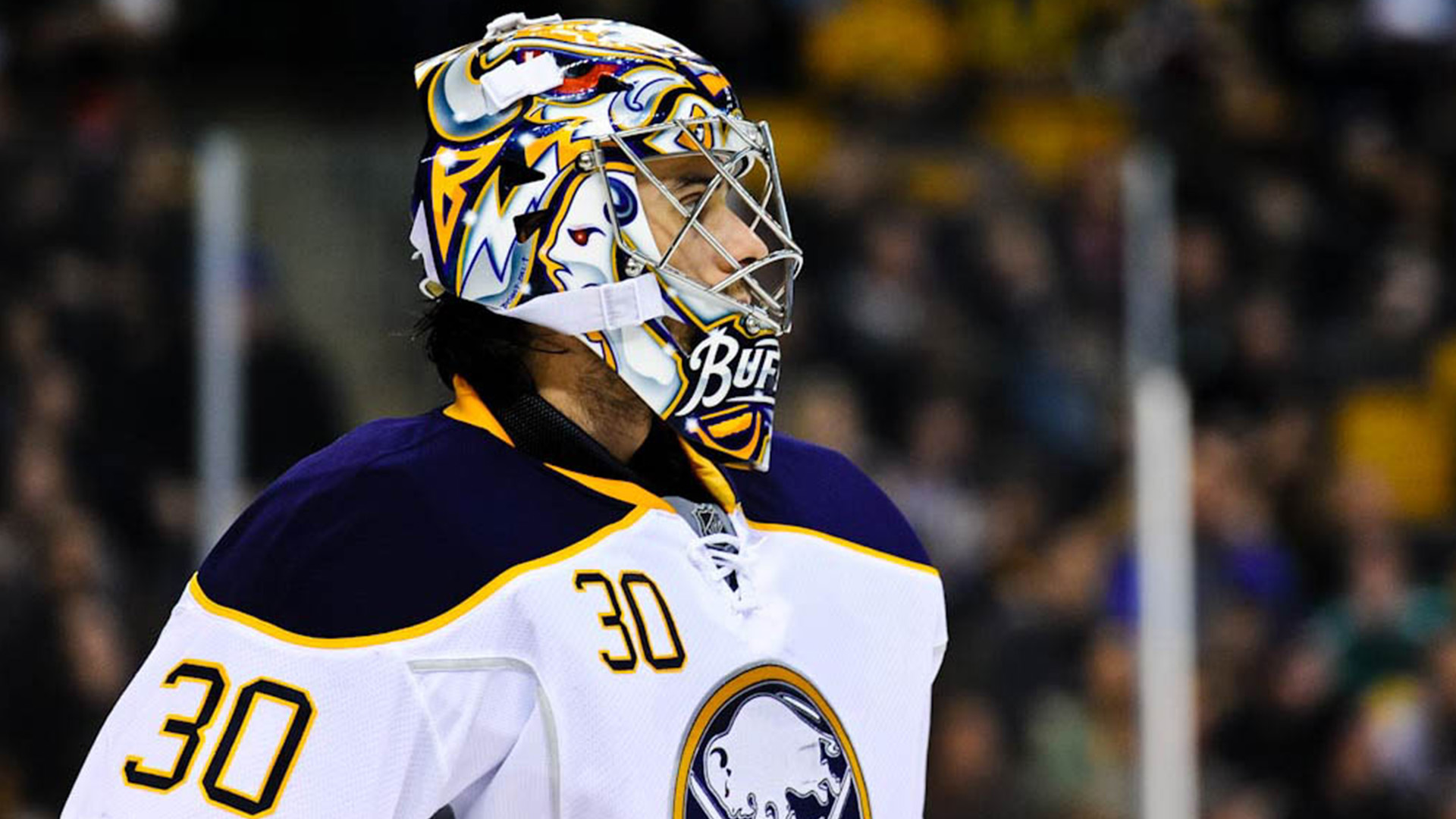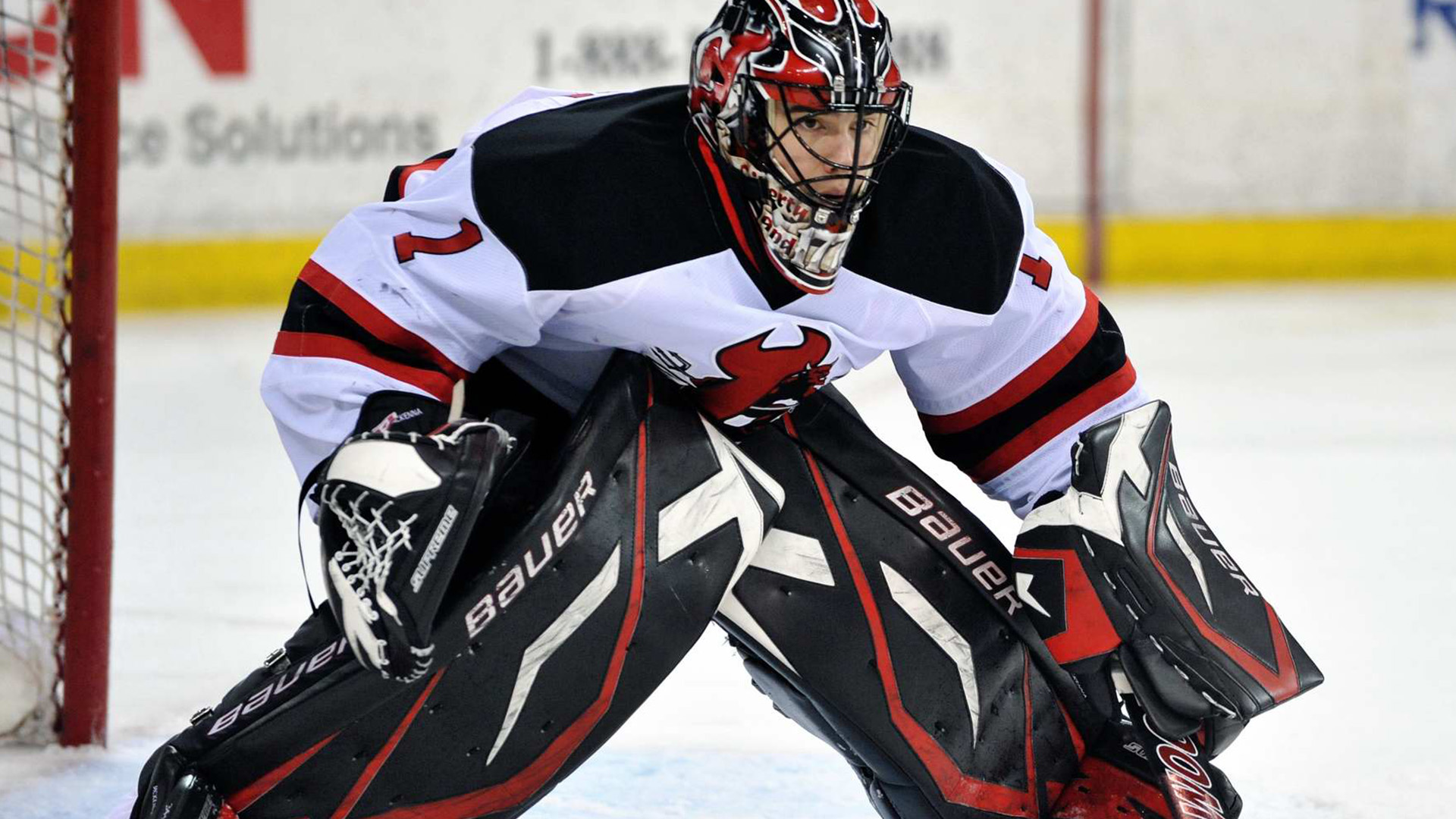
Marc-Andre Fleury photo: Bailey Hillesheim/Icon Sportswire
Is Fleury a Fit?
There isn’t much Marc-Andre Fleury hasn’t seen or done during an 18-season career that will one day end in the Hall of Fame but changing teams in-season is on that short list.
That probably explains the nerves Fleury admitted to feeling after being traded by the Chicago Blackhawks to the Minnesota Wild prior to the NHL Trade Deadline on March 21 in exchange for a conditional first round pick. Fleury knows there will be adjustments getting comfortable behind a new team, and he only has five weeks to make them before the playoffs start.
“It is a little bit (nerve racking),” Fleury admitted that day. “Just to get comfortable again and with not that many games left before playoffs start. Things got to happen quick.”
To shed a better light on some of the specific adjustments Fleury faces getting comfortable in short order, InGoal Magazine reached out to three goalies who have lived them: Eric Comrie of the Winnipeg Jets and recently retired goalies Ryan Miller and Mike McKenna. The trio shared thoughts on adjusting to a new system and the tendencies of new teammates, especially defensemen, and we examined whether the types of scoring chances the Wild surrender fit Fleury’s strengths, but all three agreed the biggest factor is not trying to do too much.
PRESSURE CAN BE A PROBLEM
It helps Fleury that he has switched teams twice the past five seasons, first after being selected by the Vegas Golden Knights in the 2017 NHL Expansion Draft following his first 13 seasons with the Pittsburgh Penguins, and again after being traded by Vegas to the Blackhawks before this season. Having gone through the process of figuring out a new system and learning to read off new teammates should help ease Fleury’s transition to the Wild, but it’s a lot different doing it in-season, in part because there’s not a lot of time — or margin for error — left.
Miller switched teams twice in the off-season and once before the NHL Trade Deadline over an 18-season career and said there’s a notable difference between the two situations.

Ryan Miller moved from Buffalo to St. Louis at the trade deadline in 2014. Photo: Scott Slingsby / InGoal
“When I switched teams and had a training camp, there’s less pressure to get things up and going with that long season ahead of you, almost like you can make some mistakes here and there,” said Miller, who retired from the NHL last summer. “When it’s the deadline, it does feel like quite a bit. You want to play your own game, you want to fit in, you want to get hot at the right time and there’s tremendous pressure to perform. Having a little time to sort that out is ideal, but at the deadline you’re immediately playing important games.”
In goaltending, much like golf, you can’t just try harder and expect good results. Goalies are better off letting the play — and the puck — come to them; forcing things rarely works out.
“Your first game, even your first practice, you go in there with the mindset of ‘I want to make a good first impression. I want to be perfect. I want to be great,’” said Comrie, who has changed teams in-season by trade or waivers five times over the past three years. “You almost put too much pressure on yourself instead of just doing what you normally do and playing your game. You get so wound up and so amped up instead of saying ‘I’m just going to play my game and let that do the talking.’ That’s one of the hardest parts I find.”
“There is not always a good fit. If you’re a good goalie you can probably have success in any scenario. But just like any player, there is a perfect scenario for you. There is a sweet spot.”
McKenna played for 23 teams in three leagues over a 14-season career that ended in 2019 and changed teams in-season 12 times through promotions from one league to another, waiver claims or trades. He experienced the pressure of being brought in specifically for a playoff run when Syracuse acquired him ahead of the 2017 trade deadline.
“The hardest part for me going at the trade deadline was that there were expectations and I needed to win,” said McKenna, who is now working as an analyst for Daily Faceoff. “I wasn’t going from the Springfield Thunderbirds to the Syracuse Crunch to just be along for the ride. I was supposed to be their starting goaltender and lead them to a Calder Cup, which is more or less what Marc-Andre Fleury has been brought in to do with the Minnesota Wild, and that wasn’t easy. I can remember I was trying so hard that I was probably overdoing it. I was trying to prove my worth.
“Even as someone who had played 12 years pro at that stage, I was still trying to prove my worth. So maybe it’s a different dynamic for me than it is Marc-Andre, who has accomplished everything, but I would imagine that nervousness is still there because you instantly want to perform for your teammates. You don’t want to let them down. It’s way more about your team and the organization than it is yourself, especially that late in your career. You just want to make everyone around you proud and to help them win and mentally that’s the biggest hurdle, I think, is to just remember to relax and go play and just have fun. Thankfully that’s something that Fleury has always carried through his career: that smile.”

Mike McKenna played for 23 teams in three leagues over a 14-season career that ended in 2019 and changed teams in-season 12 times. Photo: Scott Slingsby / InGoal
DO THE GOALIE’S STYLE AND TEAM’S SYSTEMS MATCH?
Some might wonder whether it even matters if the way the team and goalie play are a good match. To some extent, goalies are expected to adjust to whatever is in front of them, but with the stakes so high, doesn’t it make sense to try and fit a goalie’s strengths to a team’s system?
Miller certainly thinks so. When he was traded from the Buffalo Sabres to the St. Louis Blues on Feb. 28, 2014, he was expected to backstop a deep playoff run. But there were a lot of red flags when it came to fit: It was Miller’s first trade after 11 seasons with the Sabres. His new team, the Blues, gave up fewer shots and rush chances. Miller, who played with more backward flow in his game, was not as suited to a low-shot atmosphere. The defensive-zone reads around the crease also changed for a goalie who, at the time, relied more on anticipation.
Miller went from a .923 save percentage in 40 games with the struggling Sabres to a .903 in 19 regular-season games and dropped to .897 during a first-round playoff loss with the Blues.
“There’s that mindset from some that a good goalie should be able to handle all situations and be able to adjust but there are guys that do have strengths and weaknesses, so maybe it is more about the fit,” Miller said. “I would be looking for a fit.”
There are a couple of different ways to look at that fit. One involves how busy a goalie is behind each team. Some goalies thrive on seeing lots of shots and staying busy, and struggle when they’re not. There have been several examples over the years of goalies finding new ways to stay engaged when they’re not as busy, including Pekka Rinne handling the puck more.
“Some teams kill penalties a little bit differently, the D-men take way certain lanes, certain options on the ice, so it can take some time to get to know the systems. I think the toughest thing is coming into a new room and not knowing anybody, not knowing their tendencies on the ice and stuff like that.”
Fleury was kept busy at his most recent stop in Chicago, a bottom-10 team in shots against, and while he didn’t face as many in Vegas, where the Golden Knights were consistently among the five best teams in terms of shots against, he did face a lot of quality chances, especially last season. Fleury also had success playing behind a stingy Penguins team that was good at limiting both shot totals and dangerous chances during their final two Stanley Cup-winning seasons.
In other words, Fleury has shown an ability to succeed behind different workloads.
“He has played on teams that have run the gamut over the years,” Miller said. “Pittsburgh wasn’t giving up a whole lot when they were winning. It came down to ‘is there a save you wouldn’t expect a goalie to make?’ Marc is probably going to make it.”
It’s also worth looking at whether the types of scoring chances a team surrenders the most fits the strengths of the new goalie. Fleury struggled his first month in Chicago, going 1-7-0 with a .881 save percentage before the Blackhawks replaced Jeremy Colliton with Derek King as coach Nov. 6. But he pointed to improved defensive play and fewer odd-man rushes, rather than time to adjust, for a turnaround that included a .913 save percentage after the coaching change.
The good news for Fleury and the Wild is that, like Chicago under King, Minnesota doesn’t surrender as much off the rush, forcing teams to try and generate offense in zone, which is an area Fleury typically excels. According to data from Clear Sight Analytics, Chicago had the worst expected goals against the rush under Colliton, and Fleury struggled. But the Blackhawks had the fifth best expected goals against rush chances since King took over, which compares well to the Wild, who are the seventh best team in the NHL in that category this season.
Even if the chance types match a goalie’s strengths, there are still adjustments to be made learning how new teammates handle each situation, and that might be more important.
Marc-Andre Fleury saw a big change in his gme when a coaching change in Chicago improve their defensive systems to better match his strengths. Photo: Chris Kohley/Icon Sportswire
GETTING USED TO NEW TEAMMATES AND TENDENCIES
If there’s one thing that jumps out after two years of doing Pro Reads with NHL goalies, it’s that being able to anticipate and trust what teammates are going to do in specific circumstances is every bit as important as figuring out what the opponent is trying to do.
For all the talk about reading off the handedness, hand position and stick blade angles of the players trying to score on you while the puck moves around the zone, there’s usually more about knowing when, where and how — sometimes even if — your defensemen or back-checking forwards are going to pressure those players. When a goalie chooses what side of a screen to look around, it’s part of a system and being able to trust that the defenseman is on the same page and working to take away the lane on the other side of that screen.
In just about every situation, goalies make decisions about their own positioning and save selections based on being able to predict how those elements will come together, and they need to do it instinctively, without the delay of conscious thought.
“The systems definitely matter, especially on the penalty kill, because the systems give the structure your entire team is trying to work behind, but you also have to understand the personalities and nuances of the players implementing those systems,” said McKenna. “So, I think it is relationship based as much as it is learning the system because when you are facing odd-man rushes or getting out to handle a puck, you are dependent on what you have seen previously out of a teammate. If it’s a 2-on-1 and you know your defenseman likes to force, what his timing is, that gives you extra clues to be able to make a save.”
Managing screens will be especially important for Fleury in Minnesota because it was his biggest statistical weakness in Chicago this season, even after the coaching change.
“You look at certain systems that are played, and you can’t expect to go into a team that plays a completely different system than you may have played your entire career and just magically change in six weeks. That’s difficult.”
Fleury has given up almost nine more goals (8.79) than expected on shots that include a screen and has negative numbers in five of the six different screen categories: layered, one-timer, slot area, defensive and deflection. Only offensive screens are above expected this season, and one of the two goals to beat Fleury in his Wild debut Saturday came on a screened slot area shot.
“Guys are going to have to learn the tendencies,” Miller said. “I always liked knowing what my defenseman prefer to do and it’s one thing to have a conversation but I like to think that your actions speak louder than words. So, what a guy is consistently doing on the ice, his approach to the game and how he exists within the system, it’s important. You have to be a well-oiled machine. You have to know what’s going on and make split-second decisions as a group, and it takes some familiarity, and it takes some time for the new player and the group.”
Some goalies play more on anticipation than others. For example, Comrie doesn’t think he relies as much on reads as his Winnipeg playing partner, Connor Hellebuyck.
“Helle relies a lot on anticipation and he’s really good at it,” Comrie said. “He’s always telling me about the read he sees and it’s good for him because he’s so on with his reads, where I’m more ‘no, just get into position.’ That’s the way I look at it and it’s different for each guy.”
There are still some things that require everyone being on the same page.
“The big one is puck handling,” Comrie said. “Every team has different philosophy and what they want their goalies to do, different communications for the calls. That’s always tougher. In zone and 2-on-1s, you have an understanding what your guys are going to do and what they like to do, and that’s hard to adjust to. You play with a lot of different guys. You are getting used to what they like to do, but I’m still playing it my way no matter who’s doing it.”
Eric Comrie haas changed teams five times over the past three seasons. Photo: Devin Manky/Icon Sportswire
HOW LONG DOES IT TAKE TO ADJUST?
Fleury and the Wild have less than five weeks before the playoffs start, but McKenna believes that’s enough time to get comfortable even if he only plays half of the remaining 18 games, in part because that learning process continues even from the bench watching as a backup.
“If you’ve played as long in the NHL as Fleury, he’s seen all different systems, but he still needs to see it implemented in real time again to really get the feel,” McKenna said. “That’s where I do think playing eight to 10 games, watching a dozen games, it takes a month or so before you start to feel comfortable, I think, until you start to really feel ingrained in a team.”
McKenna also think’s Fleury’s personable approach will make that transition smoother.
“He’s never been traded in-season. This is all new to him. But if there’s anybody in the NHL that can walk into a locker room and instantly make bonds and friendships and know how to bridge that gap, it’s him,” McKenna said. “He’s the most joyful, outgoing person. No one’s going to look at him and think, ‘they brought in a big dog, I need to tread lightly.’ Even the youngest players know they can go up to him and say hi and learn and talk and I think that’s critical.”
Fleury and the Wild check a lot of boxes when it comes to being a good fit together.
Only time will tell if it will be enough.
Become a Member to Read All the Exclusive Goaltending Content
We’re working hard to bring you the best exclusive goaltending content whether you play goal, you are a coach, a parent of a goaltender, or a fan of the greatest position in sports.
All InGoal Premium members enjoy an ad-free experience.
Already a member?
Comments
Let's talk goaltending!
We welcome your contribution to the comments on this and all articles at InGoal. We ask that you keep it positive and appropriate for all - this is a community of goaltenders and we're here for each other! See our comment policy for more information.



